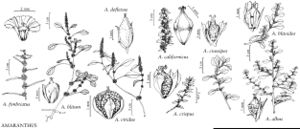Difference between revisions of "Amaranthus crispus"
in A. Gray et al., Manual ed. 6, 428. 1890.
FNA>Volume Importer |
imported>Volume Importer |
||
| (6 intermediate revisions by 2 users not shown) | |||
| Line 1: | Line 1: | ||
{{Treatment/ID | {{Treatment/ID | ||
|accepted_name=Amaranthus crispus | |accepted_name=Amaranthus crispus | ||
| − | |accepted_authority=(Lespinasse & Thévenau) A. Braun ex J. M. Coulter & S. Watson | + | |accepted_authority=(Lespinasse & Thévenau) A. Braun ex J. M. Coulter & S. Watson |
|publications={{Treatment/Publication | |publications={{Treatment/Publication | ||
|title=in A. Gray et al., Manual ed. | |title=in A. Gray et al., Manual ed. | ||
| Line 8: | Line 8: | ||
}} | }} | ||
|common_names=Crisp-leaved amaranth | |common_names=Crisp-leaved amaranth | ||
| − | |basionyms={{Treatment/ID/ | + | |special_status={{Treatment/ID/Special_status |
| + | |code=I | ||
| + | |label=Introduced | ||
| + | }}{{Treatment/ID/Special_status | ||
| + | |code=F | ||
| + | |label=Illustrated | ||
| + | }} | ||
| + | |basionyms={{Treatment/ID/Basionym | ||
|name=Euxolus crispus | |name=Euxolus crispus | ||
|authority=Les pinasse & Thévenau | |authority=Les pinasse & Thévenau | ||
| + | |rank=species | ||
| + | |publication_title=Bull. Soc. Bot. France | ||
| + | |publication_place=6: 656. 1859 | ||
}} | }} | ||
|synonyms= | |synonyms= | ||
| Line 27: | Line 37: | ||
|elevation=0-500 m | |elevation=0-500 m | ||
|distribution=N.J.;N.Y.;N.C.;Va.;native to South America (Argentina);introduced in s Eurasia and other regions. | |distribution=N.J.;N.Y.;N.C.;Va.;native to South America (Argentina);introduced in s Eurasia and other regions. | ||
| + | |introduced=true | ||
|tables= | |tables= | ||
|references= | |references= | ||
| Line 35: | Line 46: | ||
-->{{#Taxon: | -->{{#Taxon: | ||
name=Amaranthus crispus | name=Amaranthus crispus | ||
| − | + | |authority=(Lespinasse & Thévenau) A. Braun ex J. M. Coulter & S. Watson | |
| − | |authority=(Lespinasse & Thévenau) A. Braun ex J. M. Coulter & S. Watson | ||
|rank=species | |rank=species | ||
|parent rank=subgenus | |parent rank=subgenus | ||
| Line 50: | Line 60: | ||
|publication title=in A. Gray et al., Manual ed. | |publication title=in A. Gray et al., Manual ed. | ||
|publication year=1890 | |publication year=1890 | ||
| − | |special status= | + | |special status=Introduced;Illustrated |
| − | |source xml=https:// | + | |source xml=https://bitbucket.org/aafc-mbb/fna-data-curation/src/2e0870ddd59836b60bcf96646a41e87ea5a5943a/coarse_grained_fna_xml/V4/V4_843.xml |
|genus=Amaranthus | |genus=Amaranthus | ||
|subgenus=Amaranthus subg. Albersia | |subgenus=Amaranthus subg. Albersia | ||
Latest revision as of 22:01, 5 November 2020
Plants annual, sparsely pubescent. Stems prostrate to ascending, branched mainly from base, 0.1–0.4(–0.5) m. Leaves: petiole shorter than blade; blade rhombic-ovate to oblong, 0.5–1.5(–2.5) × 0.3–0.8(–1.5) cm, base cuneate, margins crisped-erose, conspicuously undulate, apex acute to subobtuse, with short mucro. Inflorescences axillary glomerules, green, axes not thickened, not indurage at maturity. Bracts lanceolate to oblong-lanceolate, 1.2–1.7 mm, ± equaling or slightly shorter than tepals. Pistillate flowers: tepals 5, spatulate-oblong, equal to subequal, 1.2–1.7 mm, margins entire, apex rounded to subacute; style branches spreading; stigmas 3, sessile. Staminate flowers intermixed with pistillate; tepals 5; stamens 5. Utricles ellipsoid or obovoid, 1.5–2 mm, slightly longer than tepals, smooth to slightly wrinkled, indehiscent. Seeds black to dark reddish brown, lenticular to obovoid-lenticular, 0.7–1 mm diam., smooth.
Phenology: Flowering summer–fall.
Habitat: Waste places, other disturbed habitats, mostly at seaports and on ballast
Elevation: 0-500 m
Distribution
Introduced; N.J., N.Y., N.C., Va., native to South America (Argentina), introduced in s Eurasia and other regions.
Discussion
Selected References
None.
